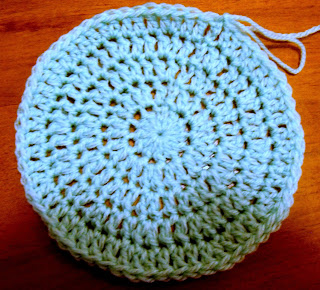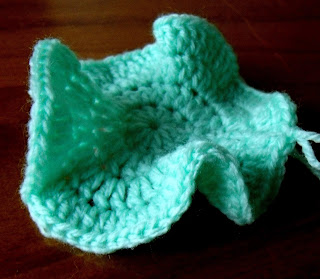I've covered several things that can go wrong with the flat circle in previous posts.
This time I will talk about hook size
This time I will talk about hook size
Sometimes
the wrong sized hook can also have an effect of the flatness of the
circle.
The above image shows the perfect flat circle worked with 8 ply yarn, and a 4 mm hook. It sits perfectly flat, and after 5 rows of tr (dc US) it measures approximately 11 mm
In
general, a too small hook will make the circle smaller. Here the same yarn is used with a 2 mm hook. This time the circle measures 8.5 mm
And a too large hook will make it larger. Here a 6 mm hook was used. It now measures 13.5 mm
But
the wrong sized hook can have a slight effect on waving or curling as
well.

Here is the circle made with the 6 mm hook. There is only a tiny bit of waving
The above image shows a slight bit of curling. This was the circle made with the 2 mm hook
Here is the circle made with the 6 mm hook. There is only a tiny bit of waving
If
for any reason the circle is wavy, the general way to fix it is to
make LESS increases, but if that is not possible, or too difficult, a
SMALLER hook can be used.

On the other hand, if the circle is curling up, you need to use MORE increases, and again, if that is not possible, or too difficult, you could try a LARGER hook
Here is a chart of the most common recommended hooks to yarn weight
Australia
|
UK
|
USA
|
Hook
Size (mm)
|
|---|---|---|---|
2
ply
|
2
ply
|
Lace
|
0.75
– 3.0 mm
|
3
ply
|
3
ply
|
Sock/
Fingering
|
2.25
– 3.5 mm
|
4
ply
|
4
ply
|
Fingering/Sports
|
2.5
– 3.5 mm
|
8
ply
|
Double
Knitting
|
Light
Worsted
|
3.5
– 4.5 mm
|
10
ply
|
Aran
|
Worsted
|
5.5
mm – 6.5 mm
|
16
ply
|
Bulky
|
Chunky
|
6.5
mm – 9.0 mm
|
20
ply
|
Chunky
|
Bulky
|
9.0
mm & above
|
More posts on making circles
Making a Flat Circle
http://craftcove.blogspot.com.au/2017/12/making-flat-circle.html
When The Flat Circle Goes Wrong
Which Hook For the Perfect Circle
https://craftcove.blogspot.com/2018/01/which-hook-for-perfect-circle.html
When a Circle is Not a Circle
https://craftcove.blogspot.com/2018/01/when-circle-is-not-circle.html





